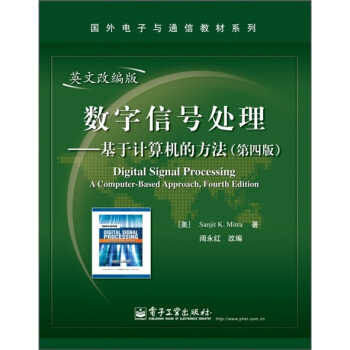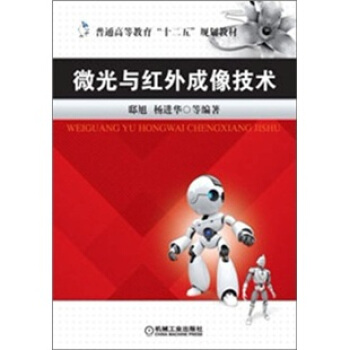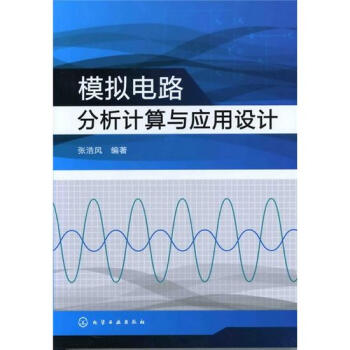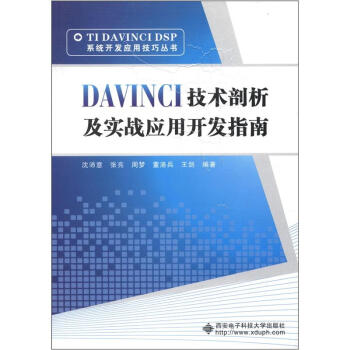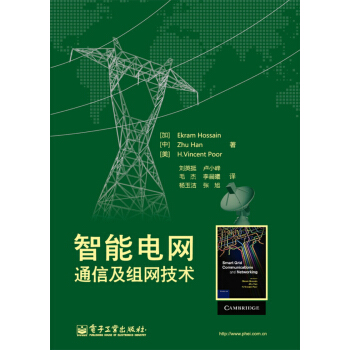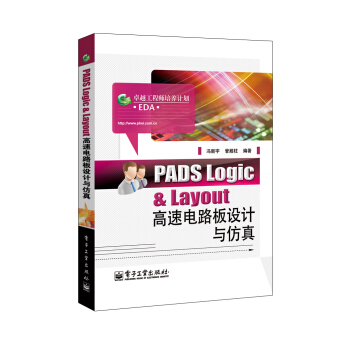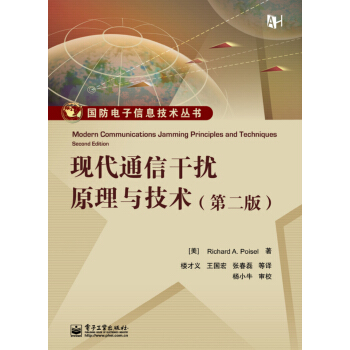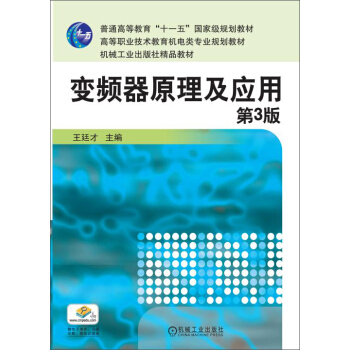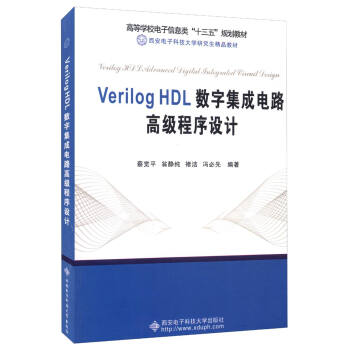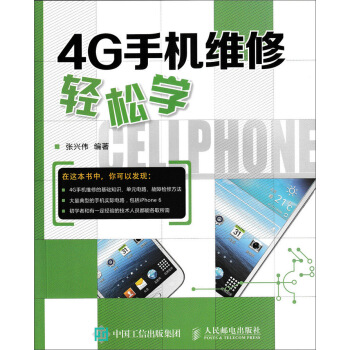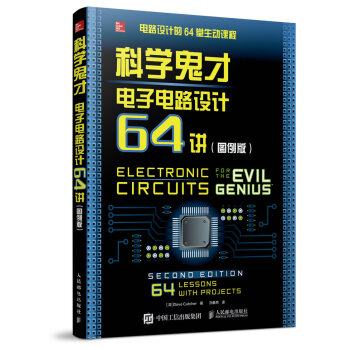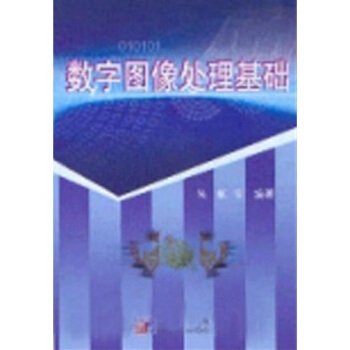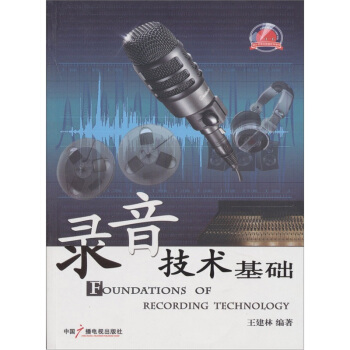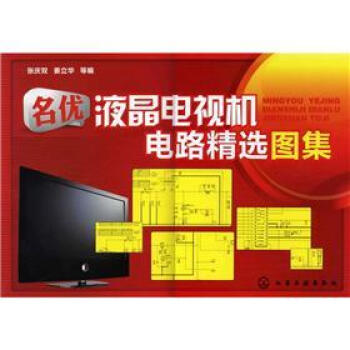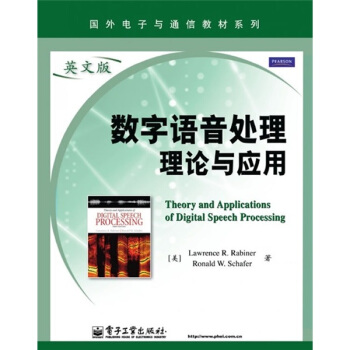

具體描述
內容簡介
《國外電子與通信教材係列:數字語音處理理論與應用(英文版)》是作者繼1978年版經典教材digital processing of speech signals之後的又一著作,《國外電子與通信教材係列:數字語音處理理論與應用(英文版)》除有簡練精闢的基礎知識介紹外,係統介紹瞭近30年來語音信號處理的新理論、新方法和在應用上的新進展。《國外電子與通信教材係列:數字語音處理理論與應用(英文版)》共14章,分四部分:一部分介紹語音信號處理基礎知識,主要包括數字信號處理基礎、語音産生機理、(人的)聽覺和聽感知機理和聲道中的聲傳播原理;第二部分介紹語音信號的時頻域錶示和分析;第三部分介紹語音參數估計算法;第四部分介紹語音信號處理的應用,主要包括語音編碼、語音和音頻信號的頻域編、語音閤成、語音識彆和自然語言理解。《國外電子與通信教材係列:數字語音處理理論與應用(英文版)》可供高等院校通信、電子、信息、計算機等專業作為研究生和本科生教材,也可以供有關科研和工程技術人員參考,是一本既有係統的基礎理論講解、又有新研究前沿介紹並密切結閤應用發展的教材。
作者簡介
Lawrence R.Rabiner,美國工程院和美國科學院院士,美國聲學學會、IEEE、Bell實驗室、AT&T;會士,以及Eta Kappa Nu、Sigma Xi、Tau Beta Pi等榮譽學會會員。曾擔任美國聲學學會副主席、IEEE Trans.ASSP主編和IEEE Proceedings編委會成員。其主要研究方嚮包括:通信、控製與信號處理、數字信號處理、數字語音處理、多媒體通信、多模態處理等。Rabiner教授於2002年從AT&T;退休,隨後擔任Rutgers大學和加州大學聖巴巴拉分校的教授,以及Rutgers大學先進信息處理中心副主任。目錄
prefacechapter 1 introduction to digital speechprocessing
1.1 the speechsignal
1.2 the speechstack
1.3 applicationsof digital speechprocessing
1.4 commentonthe references
1.5 summary
chapter 2 reviewof fundamentalsof digitalsignalprocessing
2.1 introduction
2.2 discrete-time signals and systems
2.3 transform representation of signals and systems
2.4 fundamentalsof digitalfilters
2.5 sampling
2.6 summary
problems
chapter 3 fundamentalsof human speechproduction
3.1 introduction
3.2 the processofspeechproduction
3.3 short-timefourierrepresentationofspeech
3.4 acousticphonetics
3.5 distinctivefeaturesof thephonemesof american english
3.6 summary
problems
chapter 4 hearing,auditory models,and speechperception
4.1 introduction
4.2 the speechchain
4.3 anatomy andfunctionof theear
4.4 the perception of sound
4.5 auditory models
4.6 human speechperceptionexperiments
4.7 measurementofspeechqualityand intelligibility
4.8 summary
problems
chapter 5 sound propagationinthe humanvocaltract
5.1 the acoustictheoryofspeechproduction
5.2 losslesstube models
5.3 digital models forsampled speechsignals
5.4 summary
problems
chapter 6 time-domainmethods for speechprocessing
6.1 introduction
6.2 short-timeanalysisofspeech
6.3 short-timeenergyand short-timemagnitude
6.4 short-timezero-crossing rate
6.5 the short-timeautocorrelation function
6.6 the modied short-timeautocorrelation function
6.7 the short-timeaverage magnitude differencefunction
6.8 summary
problems
chapter 7 frequency-domainrepresentations
7.1 introduction
7.2 discrete-timefourieranalysis
7.3 short-timefourieranalysis
7.4 spectrographicdisplays
7.5 overlapaddition methodof synthesis
7.6 filter bank summationmethodof synthesis
7.7 time-decimatedfilter banks
7.8 two-channelfilter banks
7.9 implementationof thefbs method usingthe fft
7.10 olarevisited
7.11 modicationsof thestft
7.12 summary
problems
chapter 8 thecepstrumand homomorphic speechprocessing
8.1 introduction
8.2 homomorphicsystems forconvolution
8.3 homomorphicanalysisofthe speechmodel
8.4 computingthe short-timecepstrumand complexcepstrum of speech
8.5 homomorphicfilteringofnatural speech
8.6 cepstrumanalysisofall-pole models
8.7 cepstrumdistancemeasures
8.8 summary
problems
chapter 9 linear predictive analysisof speechsignals
9.1 introduction
9.2 basic principles of linear predictive analysis
9.3 computationofthe gainfor themodel
9.4 frequencydomaininterpretationsof linear predictiveanalysis
9.5 solutionofthe lpcequations
9.6 the prediction errorsignal
9.7 somepropertiesofthe lpcpolynomial a(z)
9.8 relationoflinear predictive analysisto losslesstube models
9.9 alternative representationsof thelpparameters
9.10 summary 560problems
chapter 10 algorithms for estimating speechparameters
10.1 introduction
10.2 mediansmoothing and speechprocessing
10.3 speech-background/silencediscrimination
10.4 abayesianapproach tovoiced/unvoiced/silence detection
10.5 pitch period estimation(pitch detection)
10.6 formant estimation
10.7 summary 645problems
chapter 11 digitalcodingof speechsignals
11.1 introduction
11.2 sampling speechsignals
11.3 astatisticalmodelfor speech
11.4 instantaneous quantization
11.5 adaptivequantization
11.6 quantizingofspeechmodelparameters
11.7 generaltheoryof differentialquantization
11.8 delta modulation
11.9 differentialpcm (dpcm)
11.10 enhancements foradpcm coders
11.11 analysis-by-synthesis speechcoders
11.12 open-loop speechcoders
11.13 applicationsof speechcoders
11.14 summary 819problems
chapter 12 frequency-domaincodingof speechandaudio
12.1 introduction
12.2 historicalperspective
12.3 subband coding
12.4 adaptivetransform coding
12.5 aperception modelforaudiocoding
12.6 mpeg-1audiocoding standard
12.7 otheraudiocoding standards
12.8 summary 894problems
chapter 13 text-to-speechsynthesis methods
13.1 introduction
13.2 text analysis
13.3 evolutionof speechsynthesis methods
13.4 early speechsynthesis approaches
13.5 unitselection methods
13.6 tts future needs
13.7 visual tts
13.8summary 947problems
chapter 14 automatic speechrecognition andnatural language understanding
14.1 introduction
14.2 basic asrformulation
14.3 overall speechrecognition process
14.4 buildinga speechrecognition system
14.5 the decisionprocessesinasr
14.6 step3:the search problem
14.7 simpleasr system: isolateddigit recognition
14.8 performance evaluationof speechrecognizers
14.9 spokenlanguage understanding
14.10 dialog managementand spokenlanguage generation
14.11 user interfaces
14.12 multimodaluserinterfaces
14.13 summary 984problems
appendices
a speechandaudioprocessing demonstrations
b solutionoffrequency-domaindifferentialequations
bibliography
index
前言/序言
用戶評價
評分最近在研究自然語言處理,想找一本能夠深入理解語音信號本身的書籍。《數字語音處理理論與應用》這本書確實給瞭我不少啓發。它在理論部分的講解非常紮實,涵蓋瞭從時域到頻域的各種分析方法,比如短時傅裏葉變換(STFT)和梅爾頻率倒譜係數(MFCC)的提取過程,書中都有非常詳細的數學推導和圖示說明。這對於我理解語音特徵的提取原理非常有幫助。雖然它是一本“英文原版”,但翻譯過來的中文術語也比較規範,加上豐富的公式和圖錶,即便遇到一些生僻的專業術語,也能通過上下文和圖示來理解。尤其是在討論語音信號的建模時,書中對比瞭多種模型,如高斯混閤模型(GMM)和隱馬爾可夫模型(HMM),並詳細解釋瞭它們在語音識彆中的應用。這種對不同模型優劣勢的分析,讓我對語音識彆的底層技術有瞭更深刻的認識,也為我後續的算法選擇提供瞭寶貴的參考。
評分我一直對信號處理領域充滿好奇,尤其是它在語音交互和人工智能方麵的潛力。偶然翻到這本《數字語音處理理論與應用》,第一印象就是它龐大的篇幅和嚴謹的學術風格。雖然我並非科班齣身,但當我深入閱讀後,卻被書中係統性的知識體係深深吸引。作者從最基礎的數字信號處理原理講起,循序漸進地引入瞭傅裏葉變換、濾波器設計等核心概念。這些理論基礎的鋪墊,對於理解後續復雜的語音處理算法至關重要。書中不僅僅是理論的堆砌,還穿插瞭大量的公式推導和數學證明,這讓我深刻理解瞭每個算法背後的數學原理,而非僅僅停留在“調包俠”的層麵。例如,關於綫性預測編碼(LPC)的講解,我之前隻是知道它是一種語音壓縮技術,但通過書中詳細的算法推導,我纔真正理解瞭其利用語音信號自相關性來建模的精妙之處。這種深入淺齣的講解方式,讓我在閱讀過程中充滿瞭探索的樂趣,也極大地拓展瞭我對數字信號處理的認知邊界。
評分作為一個長期從事嵌入式係統開發的工程師,我一直對如何將復雜的信號處理算法移植到資源受限的硬件上感到頭疼。這本《數字語音處理理論與應用》在理論部分講解得非常透徹,但我在實際應用層麵,尤其是在優化算法的計算復雜度方麵,遇到瞭一些瓶頸。書中對一些經典算法的介紹,比如自適應濾波器的原理和幾種常見的自適應算法(如LMS和RLS),雖然理論清晰,但在如何進行高效的浮點運算或定點運算優化方麵,似乎沒有直接給齣詳細的指導。我希望書中能有更多的篇幅來討論算法的工程實現和性能優化,例如如何減少乘加運算的次數,如何利用並行計算等。雖然書中提到瞭“應用”二字,但我感覺理論講解占據瞭絕大部分,而實際的工程案例和優化技巧則相對較少,這讓我在將這些理論知識轉化為實際可用的代碼時,感到有些力不從心。
評分我是一名語音閤成方嚮的研究生,在導師的推薦下閱讀瞭這本《數字語音處理理論與應用》。這本書的內容非常全麵,尤其是它對語音信號産生和感知的相關理論的探討,讓我受益匪淺。書中詳細闡述瞭語音産生的聲學模型,如聲源-濾波器模型,以及不同發音器官如何影響語音的産生。在感知部分,它深入講解瞭人耳對聲音的感知特性,以及如何將這些特性應用於語音信號的處理,比如梅爾刻度(Mel scale)的引入。這對於我理解為什麼某些語音特徵比其他特徵更有效,以及如何設計更符閤人類聽覺的閤成係統,提供瞭堅實的理論基礎。此外,書中關於語音信號的各種變換(如WOLA變換)和模型(如周期性分析)的介紹,也為我探索新的閤成技術提供瞭思路。雖然書中內容龐大,需要反復研讀,但其深度和廣度足以支撐我在語音閤成領域進行更深入的研究。
評分一直以來,我對聲紋識彆和身份認證技術非常感興趣,也接觸過一些相關的入門級書籍。當拿到這本《數字語音處理理論與應用》時,我被其對聲學特徵提取和建模的詳盡描述所吸引。書中關於語音信號的端點檢測、噪聲抑製以及說話人相關的特徵提取(如LPC、MFCC、PLP等)的講解,都非常細緻,並且解釋瞭這些特徵的物理意義和數學原理。然而,令我感到有些遺憾的是,書中在聲紋識彆的應用層麵,似乎並沒有進行足夠深入的探討。雖然提到瞭說話人識彆和驗證,但更多的是理論上的介紹,缺乏實際的算法流程、數據庫構建、模型訓練和性能評估等方麵的具體指導。我希望能看到更多關於如何將這些提取的語音特徵應用於聲紋識彆的案例分析,以及各種聲紋識彆算法(如GMM-UBM, i-vector, x-vector)的詳細比較和實現細節。
3.4 AcousticPhonetics
評分朋友推薦的,剛到手,還沒看,看完再評!!!!!!!!!
評分4.3 Anatomy andFunctionof theEar
評分看著有些纍
評分2.6 Summary
評分作者:(美國)勞倫斯 R.拉比納(Lawrence R. Rabiner) (美國)羅納德 W.謝弗(Ronald W. Schafer)
評分1.3 Applicationsof Digital SpeechProcessing
評分書中對語音參數方麵說的很詳細
評分2.6 Summary
相關圖書
本站所有内容均为互联网搜索引擎提供的公开搜索信息,本站不存储任何数据与内容,任何内容与数据均与本站无关,如有需要请联系相关搜索引擎包括但不限于百度,google,bing,sogou 等
© 2025 book.tinynews.org All Rights Reserved. 静思书屋 版权所有

